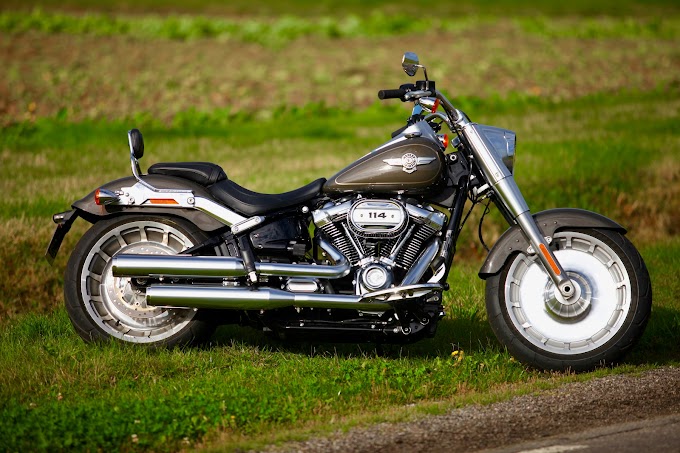The motorcycling giant Harley Davidson has a number of variants across its different segments available across the international market and among the V-Twin based engines, the Harley Davidson Fat Boy comes with solid cast disc-based wheels among the ‘softail cruisers’. This model’s design was made by Willie G. Davidson and Louis Netz. The prototype of the Fat Boy was built in Milwaukee for serving the purpose of participating in the Daytona Bike Week rally that took place somewhere across the year 1988 and 1999. FLSTF were the codes assigned to the Fat Boys that were produced between 1990 and 2017 while the models produced from 2018 were coded as FLFB and FLFBS respectively.
A frequently aroused untrue etymology narrates that the name ‘Fatboy’ is the outcome of the names of atomic bombs that were dropped in Japan during World War II, i.e ‘Fat Man’ and ‘Little Boy’, symbolising the insult of the Japanese motorcycles. Although such claims have been debunked for the fact that, upon observation the ‘Fatboy’ from a head-on view it was found that the motorcycle was much wider than any other compared models. In an interview taken in 2015, the vice president: styling and product development, Mr Scott Miller stated that the name is just descriptive and it has nothing to pinch its Japanese motorcycling competitors.
History and subsequent development of Harley Davidson Fat Boy
The frame of the Fat Boy is acquired from ‘Softail’ of 1984. It has a chassis of rigid hardtail accompanied by a swingarm concealed by springs and this was designed in a garage of Missouri during the 1970s by Bill Davis, a mechanical engineer and was patented later in 1976. Willie G, who is the grandson of Harley-Davidson’s co-founder William A. Davidson initially turned down the concept of Bill’s softail. Later in due course of time, the company backed down and bought the rights for designing its in-house softail frame.
• Post 1994, the seamless exhaust was introduced to the model.
• In 1996, revision in the switch gear and the master cylinder was made.
• In 1999 a new Twin Cam engine (1450 cc) was used for the model year of 2000 thereby necessitating an engine of bespoke variant and subsequent changes of the frame.
• In 2002 additions of bullet styled indicator lamps, immobilizer and alarm were made.
• In 2005, a new 15th year Anniversary version was launched and sold across the market which was specially painted, had custom wheel and came with a ‘Screamin Eagle’ engine.
• The year 2007 marked the change in the engine, increased to 1584 cc and six speed gear transmissions.
• The year 2010 witnessed the lowest ever height that Harley Davidson Fat Boy and other variant ever had. FLSTFB or “Fat Boy Lo’ was introduced in this format.
• The year 2012 brought another hike in the cubic capacity of the Harley Davidson Fat Boy. A new 1690 cc Twin Cam engine dominated the market along with other softails.
• The 2018s witnessed entirely redesigned frame for the softails consisting of Showa suspensions for both the ends and brand new Milawukee Eight engines which was twin counterbalanced model. The two variants are FLFB 1746 cc delivering 148 N.m torque and FLFBS 1868 cc delivering 164 N.m torque.
The later version of 2018, Softails has modified swingarm consisting of monoshock suspension at the rear from Showa which was mounted underneath the seat that replaced the earlier version of twin shocks. This change brought a more comfortable ride and better handling to the machine. The front forks are SDBV based, commonly known as Dual Bending Valve from Showa which is basically a cartridge simulator that uses two valves for controlling the compression and rebounding damping thereby providing linear damping feature which is proportional to speed of the fork stroke. The Harley Davidson Motorcycling company makes a claim of the 2018 chassis being stiffer and lighter as compared to its previous sibling of Dyna and Softail variants. Many more upgrades have added the ‘Lakester’ rim of 18 inch, wider 160 mm front tire, 240 mm rear tire and exclusively new in the segment LED headlamp. Being considered for the 2020, the Harley Davidson Fat Boy comes with the exclusive Milwaukee-Eight 114 engine and apart from this, Harley Davidson too produced an exclusive 30th Anniversary edition during 2020. The Harley Davidson Fat Boy is said to be the most popular and best-selling model that has been seen to have appeared in different TV programs and iconic films like Terminator 2 and Terminator Genisys. The film based model which was used in Terminator 2 is now a glamorous showpiece
that is displayed in the Harley Davidson Museum.



0 Comments